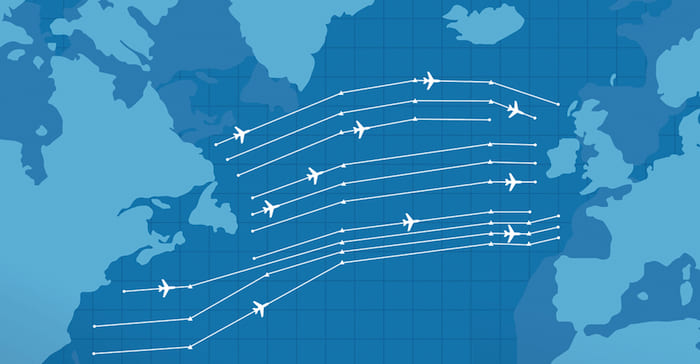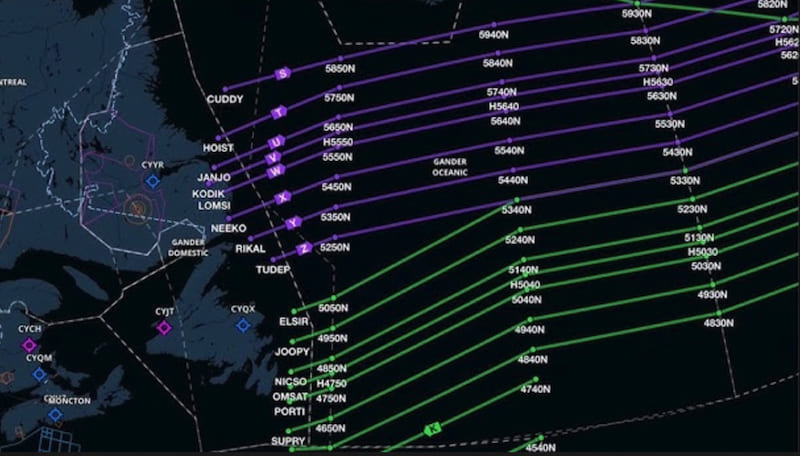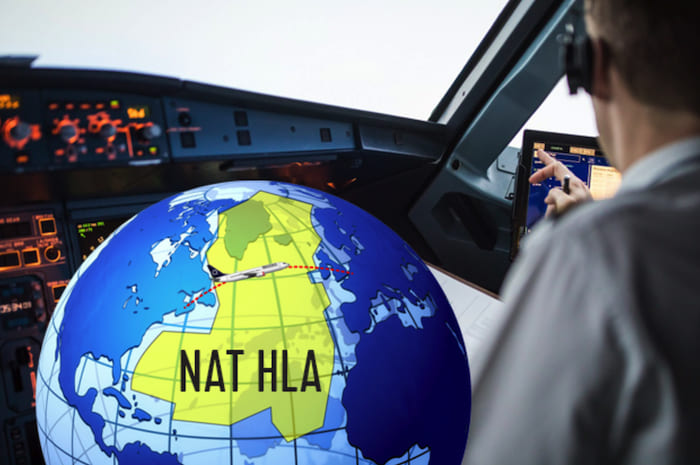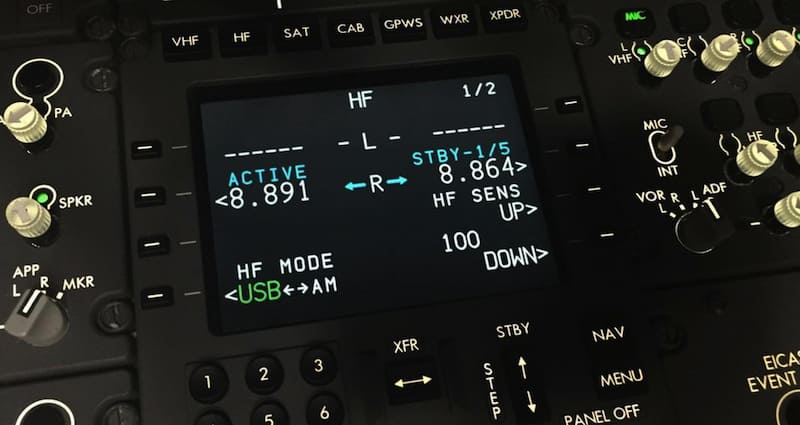Which area is NOT part of the NAT High-Level Airspace (HLA)?
Which frequency is used for inter-pilot air-to-air VHF communications?

An air-to-air VHF frequency has been established for worldwide use when aircraft are out of range of VHF ground stations which utilise the same or adjacent frequencies. This frequency, 123.450 MHz, is intended for pilot-to-pilot exchanges of operationally significant information (N.B. It is not to be used as a 'chat' frequency).
Unless providing position reports via ADS-C, if the estimated time for the 'next position', as last reported to ATC, has changed by _____, a revised estimate must be transmitted to the ATS unit concerned as soon as possible.
There are seven radio stations in the NAT: Bodo Radio (Norway), Scotland Radio (UK), Gander Radio (Canada), Iceland Radio (Iceland), New York Radio (USA), Santa Maria Radio (Portugal) and Shanwick Radio (Ireland).
There are six and not seven radios: Scotland radio is NOT one of the radio stations available in the NAT.
The hours of validity of the two Organised Track Systems (OTS) are organized as follows. For Westbound flights, day-time OTS are scheduled from 1130 UTC to _____at 30°W. For Eastbound flights, night-time OTS are scheduled from 0100 UTC to _____ at 30°W.
Changes to these times can be negotiated between Gander and Shanwick OACs and the specific hours of validity for each OTS are indicated in the NAT track message. For flight planning, operators should take account of the times as specified in the relevant NAT track message(s).
What is the common exclusion list maintained by North Atlantic States for?
How often should altimeter checks be performed while flying in the NAT HLA?
Which function prevents pilots from acting on a CPDLC uplink message delayed in the network?
What does PBCS stand for?

The performance-based communication and surveillance (PBCS) framework allows for higher safety standards and more efficient airspace use. An aircraft sends surveillance information to ATC about where it is; the aircraft stays within confines of RNP navigation requirements and ATC communicates with the aircraft within the required transaction times. The PBN (RNP/RNAV) only requires that the operator obtains approval because it focuses on how the equipment works. PBCS (RSP/RCP) however requires the involvement and approval of the air traffic service provider because it’s a two-way communication and surveillance effort. There are dependencies and complexity with the equipment standards on both ends.
What should be done if a CPDLC uplink message is delayed in the network?
Advertisement
Use of the OTS tracks is not mandatory. Aircraft may flight plan on random routes which remain clear of the OTS or may fly on any route that joins, leaves, or crosses the OTS.
VOLMET Services is a H24 continuous voice broadcast of weather information consisting of _____ for the principal airports in North America and Europe provided by Gander, New York and Shanwick.
If the flight crew does not receive its domestic frequency assignment by ____ prior to the flight’s entry into the next OCA, the flight crew should contact the aeronautical radio station and request the frequency, stating the current OCA exit fix or coordinates.
Which section of the ICAO flight plan must contain the 'X' for NAT HLA approval?
Within a few minutes of crossing an oceanic waypoint pilots should crosscheck the coordinates of the next and subsequent ('next + 1') oceanic waypoints. This check should be done by comparing the expanded coordinates against the Master Document based on the currently effective ATC clearance.
As per the NAT Doc 007, the flight crew should also verify the course/heading and distance in the FMS to the next waypoint matches the Master Document. The flight crew should confirm autopilot steering is engaged in the proper lateral (LNAV/NAV) mode.
What equipment must all aircraft intending to operate within the NAT HLA be equipped with?

RVSM MASPS are contained in the Manual on Implementation Vertical Separation (Doc 9574).
What is considered a failed system in the context of NAT HLA operations?

The provision of WAH (When Able Higher) reports advises ATC of the time or position that a flight will be able to accept the next higher level allowing controllers to more effectively utilize their airspace and provide aircraft more fuel-efficient profiles. A WAH report should be provided by all flights when entering the Santa Maria, the New-York and the Shanwick OCAs.
A WAH report should be provided by all flights when entering the Santa Maria OCA. Provision of WAH reports on entering other NAT OCAs is optional or they may be requested by any OAC. Information provided of the aircraft’s future altitude 'ability' will not automatically be interpreted by ATC as an advance 'request' for a climb. It will be used as previously indicated to assist ATC in planning airspace utilization.
Which system is used for surveillance services in the NAT region?
Multiateration is defined by a group of equipment configured to provide position derived from the secondary surveillance radar (SSR) transponder signals (replies or squitters) primarily using time difference of arrival (TDOA) techniques. Additional information, including identification, can be extracted from the received signals.
Which flight level is available for non-RVSM approved aircraft in the NAT HLA?

Advertisement
Which document provides the construction details of the OTS?
NAT Doc 007, formally known as the North Atlantic Operations and Airspace Manual, is the official real-world document outlining the procedures and regulations for the North Atlantic oceanic airspace.
What type of navigation performance must aircraft meet to operate within the NAT HLA?
When do the OTS (Organized Track System) changeover periods typically occur?

About half of NAT flights are routed via an Organized Track System (OTS) track and a large portion of the remaining random-route flights follow routes that at some point approach within one or two degrees of latitude from the outermost OTS tracks.
When 'operations normal' reports are transmitted by flight crews, they should consist of the prescribed call followed by the words 'OPERATIONS NORMAL'.
If necessary initial contact for relays or offset coordination can be established on 121.500 MHz, although great care must be exercised should this be necessary, in case this frequency is being used by aircraft experiencing or assisting with an ongoing emergency.
Operations in the NAT outside VHF coverage require the carriage of two long range communication systems, one of which must be HF. SATVOICE and/or CPDLC (appropriate to route of flight) may satisfy the requirement of the second-long range communication system.
Which special route is available for aircraft equipped only with short-range navigation equipment?
Aircraft that are equipped only with short-range navigation equipment (VOR, DME, ADF) may operate through the NAT HLA but only along routes G3 or G11. However, once again formal State approval must be obtained.
What is the flight level range defined for NAT HLA?

At what flight levels is RVSM applied in the NAT region?

Navigation Accuracy Check - Before oceanic entry, the accuracy of the GNSS navigation equipment (FMS) must be checked.
Before oceanic entry, the accuracy of the GNSS navigation equipment (FMS) SHOULD (and not MUST) be checked.
Advertisement
Operations in the NAT outside VHF coverage require the carriage of two long range communication systems, one of which must be HF.

Which agency maintains the North Atlantic Regional Monitoring Agency (RMA) database?
The purpose of the NAT Central Monitoring Agency (CMA) database is to facilitate tactical monitoring of aircraft approval status.
Who is ultimately responsible for checking that a NAT HLA/RVSM flight has the necessary approvals?
Which system provides automated position reporting in the NAT region?
Automatic dependent surveillance - contract (ADS-C) is a datalink-based way of requesting different types of information directly from the aircraft’s flight management system, without pilot interaction.
